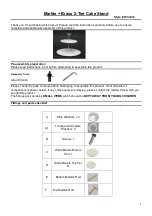
Models LB480A/LB680A
USB Powe™
Product Manual PPA (Pulse Profiling Application)
Revision: 08/02/11
11
3. Pulse Profiling Overview
Quick Start Guide and Additional Documentation
It is highly recommended that you start with the Quick Start Guide for the
Pulse Profiling Application
to quickly learn
the basics of instrument operation. This product manual can then be used as a comprehensive reference for additional
information
. (Alternately, if you want to use the sensor simply as a CW or pulse power meter, refer to the LBXXXA
Quick Start Guide and Product Manual for the Power Meter Application).
Measurement Capability
The LB480A/LB680A are specifically designed for those applications requiring a time domain analysis of pulse and
other modulated signal formats
.
Both models use a repetitive under-sampling technique to reconstruct the input
signal. This results in an effective sample rate of up to 48 MS/s. Signals with modulation bandwidths up to 10 MHz can
be measured with a high degree of accuracy
The differences between the two models are frequency range coverage and noise floor. The LB480A is specified from
100 MHz to 8 GHz with a noise floor < -60 dBm for frequencies < 6 GHz. The LB680A is specified from 50 MHz to 20
GHz (18.6 GHz with Type N connectors) and has a noise floor of -40 to -45 dBm.
The application provides five (5) pairs of markers and five (5) pairs of time gates that are used to take measurements.
The time gates allow characterization of the pulse signal to include the following parameters. There is also an
automatic measurement feature that allows all of these measurements to be made with a click of a button:
1. Rise time (RT)
2. Fall time (FT)
3. Pulse width (PW)
4. Pulse repetition time (PRT)
5. Pulse repetition frequency (PRF)
6. Duty cycle (DC)
7. Pulse power (Pls)
8. Peak power (Pk)
9. Average power (Avg)
10. Crest factor (CF or CrF)
11. Overshoot (OvSh)
12. Droop (Droop)
13. On/Off ratio
The gates also provide three groups of canned measurements:
1. Power Set (peak power, pulse power and crest factor)
2. Time & Frequency Set (pulse width, pulse repetition time, pulse repetition frequency)
3. Mixed Set (peak power, crest factor, pulse width, pulse repetition frequency)
Zeroing and Reference Power Calibration
The innovative design (patent pending)
of the Powe™ does not require zeroing or power calibration before
use and there is no provision for zeroing or calibration.












































